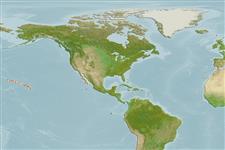>
Tetraodontiformes (Puffers and filefishes) >
Triacanthodidae (Spikefishes) > Hollardiinae
Eponymy: Dr Henri Louis Gabriel Marc Hollard (1801–1866) was a French physician and zoologist. [...] Dr William Alonzo Gosline (1915–2002) was an ichthyologist and botanist at the University of Michigan. [...] (Ref. 128868), visit book page.
Environment: milieu / climate zone / depth range / distribution range
Ekologi
marina bentopelagisk; djupintervall 275 - 366 m (Ref. 31667). Tropical
Eastern Central Pacific: Hawaii.
Size / Vikt / Age
Maturity: Lm ? range ? - ? cm
Max length : 14.4 cm SL hane/ej könsbestämd; (Ref. 28618)
Found over sand and rock, with soft corals at 275-515 m (Ref. 58302).
Life cycle and mating behavior
Könsmognad | Reproduktion | Lek | Ägg | Fecundity | Larver
Matsuura, K., 2015. Taxonomy and systematics of tetraodontiform fishes: a review focusing primarily on progress in the period from 1980 to 2014. Ichthyol. Res. 62(1):72-113. (Ref. 97685)
IUCN Red List Status (Ref. 130435: Version 2024-1)
Threat to humans
Harmless
Human uses
Verktyg
Special reports
Download XML
Internet-källor
Estimates based on models
Preferred temperature (Ref.
123201): 3.8 - 9, mean 6.2 °C (based on 6 cells).
Phylogenetic diversity index (Ref.
82804): PD
50 = 0.6250 [Uniqueness, from 0.5 = low to 2.0 = high].
Bayesian length-weight: a=0.01995 (0.00906 - 0.04395), b=3.01 (2.83 - 3.19), in cm total length, based on all LWR estimates for this body shape (Ref.
93245).
Trofisk nivå (Ref.
69278): 4.4 ±0.8 se; based on size and trophs of closest relatives
Fishing Vulnerability (Ref.
59153): Low vulnerability (10 of 100).
